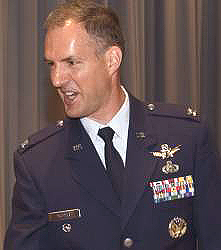The U.S. Air Force has awarded Lockheed Martin Company a $6 million contract to develop and integrate a demonstration payload that will temporarily transmit an L5 civil signal on a modernized GPS Block IIR (GPS IIR-M) satellite.
The U.S. Air Force has awarded Lockheed Martin Company a $6 million contract to develop and integrate a demonstration payload that will temporarily transmit an L5 civil signal on a modernized GPS Block IIR (GPS IIR-M) satellite.
Meanwhile, a request for proposals (RFP) was released in mid-April for the next-generation Block III space segment contract. An RFP for the GPS was released to industry on February 23.
This new L5 contract directs Lockheed Martin and its navigation payload supplier ITT in Clifton, N.J., to provide an on-orbit demonstration capability for the new civil signal located on the L5 frequency (1176MHz). The Block IIR-M spacecraft with the demonstration payload is planned for launch in 2008.
L5 will be a regular part of the GPS signals transmitted by the follow-on GPS satellites (Block IIF) being built by Boeing Company. The first IIF launch is also scheduled for next year.
“We are pleased the Air Force has entrusted Lockheed Martin to provide this important on-orbit demonstration on a Block IIR-M spacecraft,” said Don DeGryse, Lockheed Martin’s vice president of navigation systems.
Lockheed Martin Space Systems, Valley Forge, Pa., is the prime contractor for the GPS IIR program. The company designed and built 21 IIR spacecraft for the GPS Wing (formerly the NAVSTAR GPS Joint Program Office), Space and Missile Systems Center, Los Angeles Air Force Base, California.
With the first launch nearly 10 years ago, all of the 15 IIR satellites activated to date are still operating on orbit.
The final eight spacecraft, designated Block IIR-M, were modernized to enhance operations and navigation signal performance for military and civilian GPS users around the globe. ITT supplied all 21 navigation payloads for both the IIR and IIR-M spacecraft.
GPS Wing Leadership to Change.
The GPS Wing will have a new leader this summer, when Col. David Madden becomes the commander there, replacing Col. Wesley “Al” Ballenger.
Madden became vice-commander of the GPS Wing in July 2006. Although his return to Los Angeles AFB is recent, Madden has had previous experience in GPS-related programs. From July 2001 to September 2002, he was the Combat Survivor Evader Locator (CSEL) program manager, at GPS JPO and then, until July 2004, chief of the Command, Control, Communications and Navigation Division, Directorate of Requirements, in Air Force Space Command headquarters at Peterson Air Force Base, Colorado.
Copyright 2007 Gibbons Media and Research LLC



